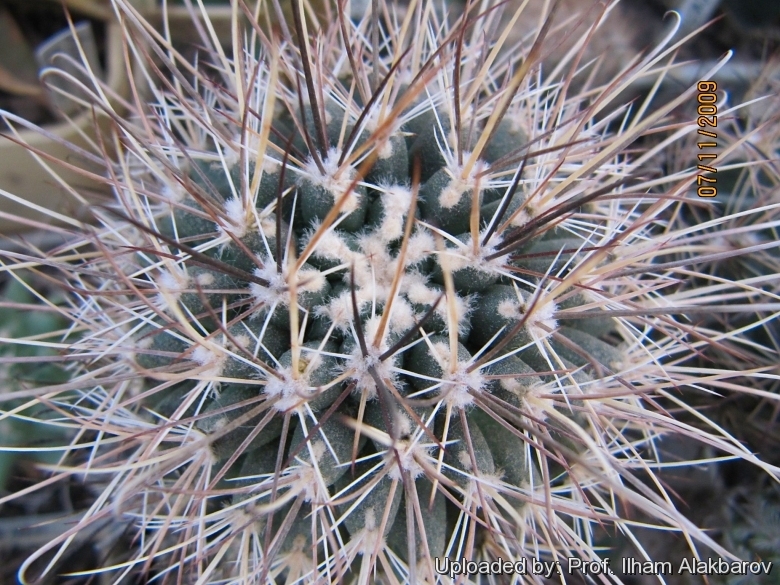Donate now to support the LLIFLE projects.
Your support is critical to our success.
Your support is critical to our success.
Accepted Scientific Name: Sclerocactus parviflorus subs. intermedius (Peebles) K.D.Heil & J.M.Porter
Haseltonia 2: 27. 1994

Sclerocactus intermedius (Sclerocactus parviflorus subs. intermedius) Photo by: Prof. Ilham Alakbarov
Synonyms:
- Sclerocactus parviflorus subs. intermedius (Peebles) K.D.Heil & J.M.Porter
- Pediocactus parviflorus subs. intermedius (Peebles) Halda
- Sclerocactus intermedius Peebles
- Sclerocactus parviflorus var. intermedius (Peebles) D.Woodruff & L.D.Benson
- Sclerocactus whipplei var. intermedius (Peebles) L.D.Benson
See all synonyms of Sclerocactus parviflorus
back
Accepted name in llifle Database:Sclerocactus parviflorus Clover & Jotter
Bull. Torrey Bot. Club 68: 419, fig. 1941
Synonymy: 6
- Sclerocactus parviflorus Clover & Jotter
- Echinocactus parviflorus (Clover & Jotter) L.D.Benson
- Ferocactus parviflorus (Clover & Jotter) N.P.Taylor
- Pediocactus parviflorus (Clover & Jotter) Halda
- Sclerocactus contortus K.D.Heil
- Sclerocactus parviflorus var. blessingiae W.H.Earle
Sclerocactus parviflorus subs. havasupaiensis (Clover) Hochstätter
Succulenta (Netherlands) 74: 38. 1995
Synonymy: 7
- Sclerocactus parviflorus subs. havasupaiensis (Clover) Hochstätter
- Echinocactus parviflorus var. havasupaiensis (Clover) L.D.Benson
- Pediocactus parviflorus subs. havasupaiensis (Clover) Halda
- Sclerocactus havasupaiensis Clover
- Sclerocactus havasupaiensis var. roseus Clover
- Echinocactus parviflorus var. roseus (Clover) L.D.Benson
- Sclerocactus whipplei var. roseus (Clover) L.D.Benson
Sclerocactus parviflorus subs. intermedius (Peebles) K.D.Heil & J.M.Porter
Haseltonia 2: 27. 1994
Synonymy: 6
- Sclerocactus parviflorus subs. intermedius (Peebles) K.D.Heil & J.M.Porter
- Pediocactus parviflorus subs. intermedius (Peebles) Halda
- Sclerocactus intermedius Peebles
- Sclerocactus parviflorus var. intermedius (Peebles) D.Woodruff & L.D.Benson
- Sclerocactus whipplei var. intermedius (Peebles) L.D.Benson
- Sclerocactus whipplei var. reevesii Castetter, P.Pierce & K.H.Schwer.
Sclerocactus parviflorus subs. macrospermus (Hochstätter) Hochstätter
Gen. Sclerocactus 27. 2005 nom. inval. without exact basionym page; see Art. 33.3 note 1 ICBN (2000)
Synonymy: 2
- Sclerocactus parviflorus subs. macrospermus (Hochstätter) Hochstätter
- Sclerocactus parviflorus f. macrospermus Hochstätter
Sclerocactus parviflorus subs. terrae-canyonae (K.D.Heil) K.D.Heil & J.M.Porter
Haseltonia 2: 27. 1994
Synonymy: 3
- Sclerocactus parviflorus subs. terrae-canyonae (K.D.Heil) K.D.Heil & J.M.Porter
- Sclerocactus parviflorus f. terrae-canyonae (K.D.Heil) Hochstätter
- Sclerocactus terrae-canyonae K.D.Heil
Sclerocactus parviflorus subs. variiflorus (Hochstätter) Hochstätter
Gen. Sclerocactus 29. 2005 nom. inval. without exact basionym page; see Art. 33.3 note 1 ICBN (2000)
Synonymy: 2
- Sclerocactus parviflorus subs. variiflorus (Hochstätter) Hochstätter
- Sclerocactus parviflorus f. variiflorus Hochstätter
back
| Your Actions | |
|---|---|
| Back to Sclerocactus index | |
| Back to Cactaceae index | |
 |
Back to Cacti Encyclopedia index |








